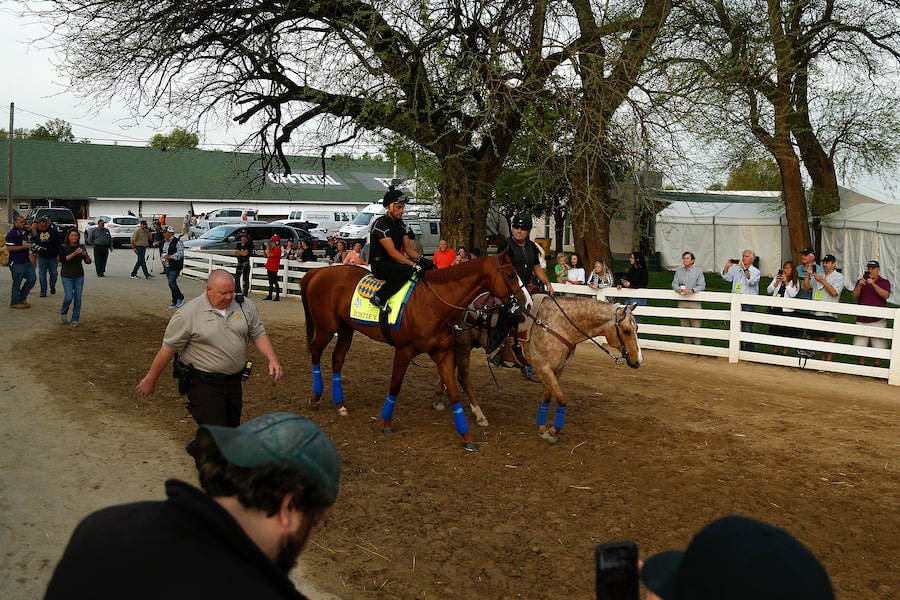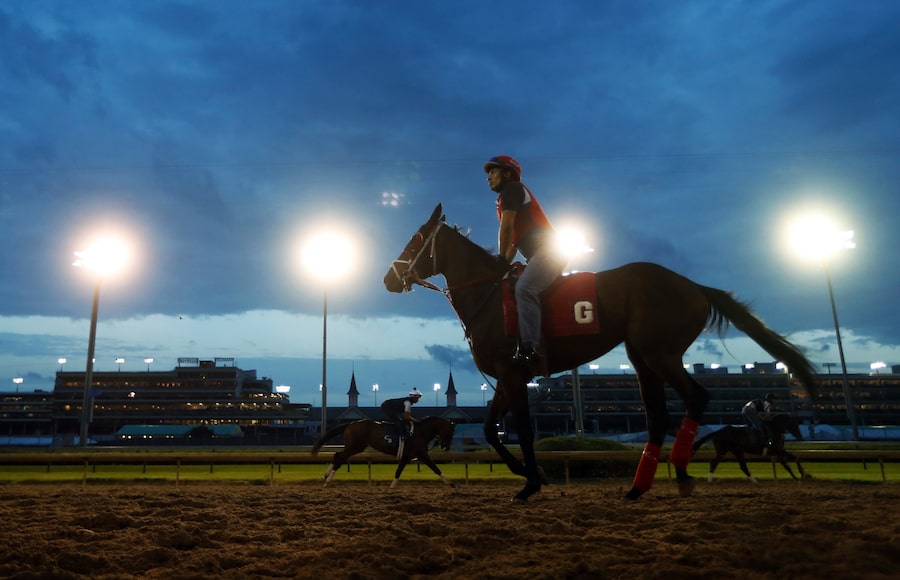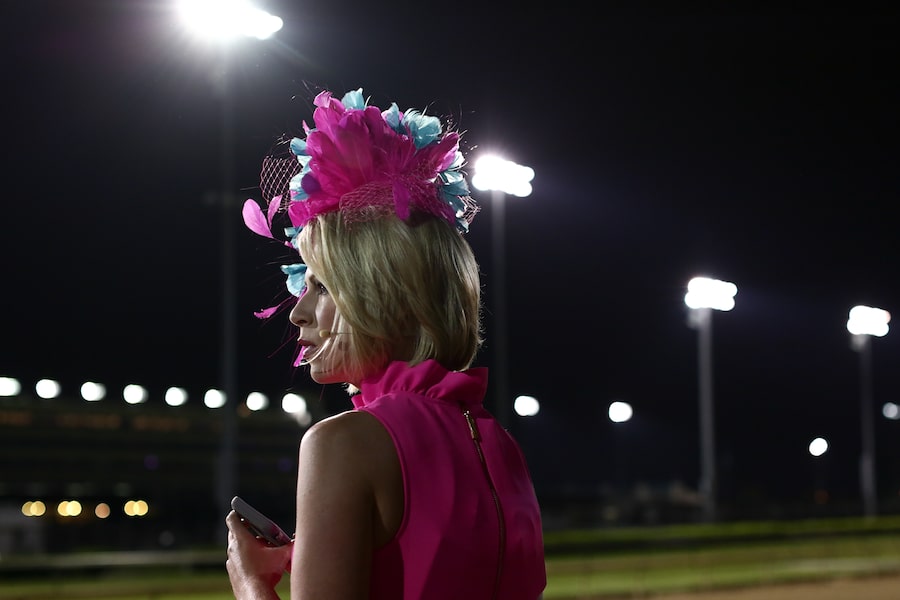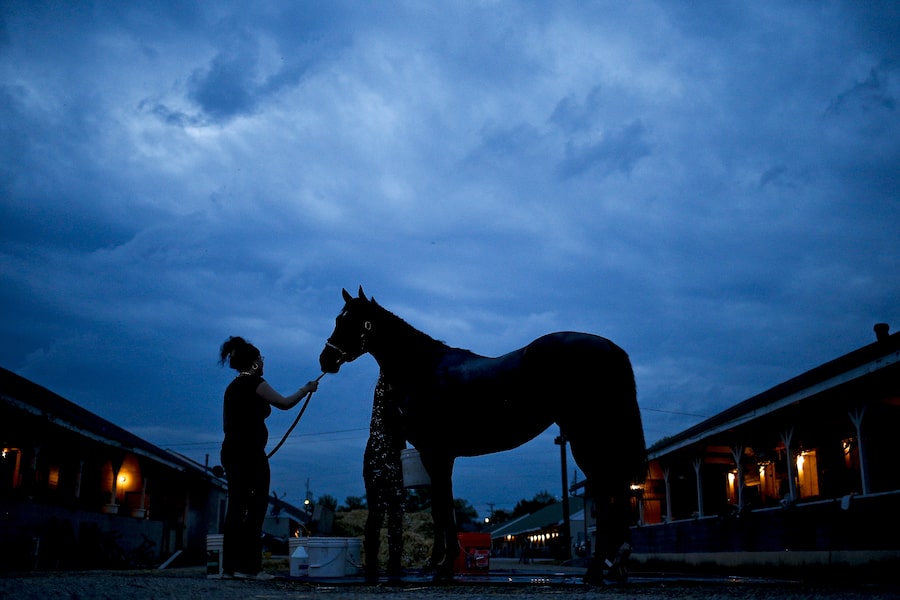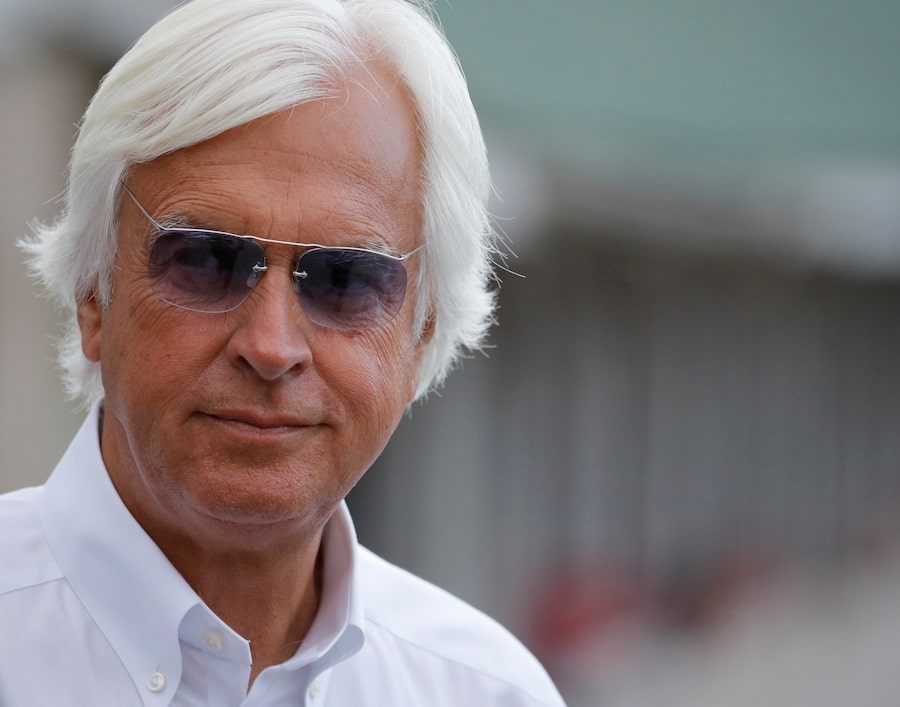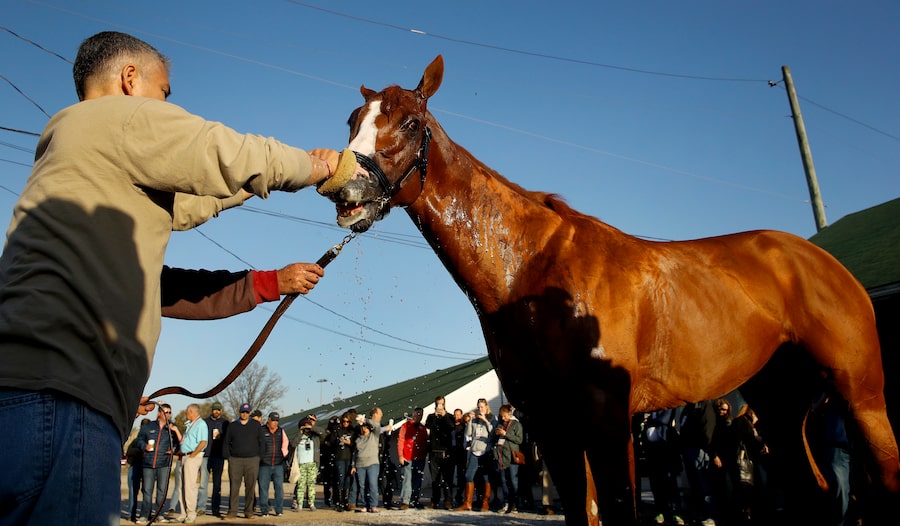A mare and foal at the Kentucky Horse Park.kentuckytourism.com
There’s no bucket of Champagne on ice in the stud barn, no Barry White on the stereo, no chocolate-dipped strawberries in the fridge. There are no curtains blowing softly in the breeze, only blue padded walls and shredded rubber tires underfoot, in case an amorous encounter goes badly awry. And yet, undeniably, this is where the magic happens.
Here in Lexington, Ky, the magic happens three times daily in the Godolphin Stable’s breeding shed, at 7:30 a.m., 1:30 p.m. and 6:30 p.m., and there are guided tours for those horse-mad aficionados inclined to watch the process. At those times, one of Godolphin’s 10 exquisitely valuable thoroughbred stallions – three of them former Kentucky Derby winners – is brought into the cavernous barn, which is cleaner than many restaurant kitchens. He will be met by a mare who is ovulating, her tail wrapped, her front legs hobbled.
The mare, whose owner has paid many thousands for the breeding session, will already have been primed to see whether she, um, consents. This is the work of the luckless teaser stallion, who has one of the less prestigious jobs in the equine world. “If the mare’s ready, she’ll look back,” says Vicky Van Camp, Godolphin’s racing research administrator, who is leading our tour. “If she’s not, she’ll kick. You don’t want your stallion getting kicked.”
A successful stud will breed with, or “cover,” upward of 150 mares in a season, which runs from Feb. 15 until the end of June. All the sires have distinctive personalities: tall, grey Frosted is “quite the ladies’ man”; Bernardini, winner of the Preakness Stakes, is “a real gentleman.” Godolphin’s prize is Medaglia d’Oro, a muscular dark beauty and sire of champions who looks up from lunch in his roomy stall when visitors enter the stallion barn. Medaglia d’Oro’s stud fee is a gold-medal $250,000 a pop, and in 2016 he covered 140 mares. You do the math.
Only the very top tier of male racehorses makes it to this particular Eden, and those who shoot blanks – like the great Cigar, a dud as a sire – do not get to stay. “Getting into the stud barn,” Van Camp says, “is a lot like getting into the NBA.”
If you take a tour of the Lexington branch of Godolphin, which is part of Sheikh Mohammed bin Rashid Al Maktoum’s racing empire (the largest in the world), you’ll also be allowed to visit the nursery barn. Broodmares and their adorable knock-kneed, fuzzy-eared foals gaze out from their stalls at visitors who might just be bearing peppermints. For part of the day, they’re turned out to run and play on the legendary grass of Kentucky. The soil sits on a limestone foundation, which is said to provide the minerals that uniquely enrich the state’s two great exports: racehorses and bourbon.
Amani, a mare, and her foal, sired by American Pharoah, at Sumaya Farm in Paris, Ky., May 2, 2017. Broodmares and their foals are turned out for part of the day to run and play.CHRISTIAN HANSEN/The New York Times
Those are also the two great resources of Kentucky tourism, and each is in the midst of a new push for visitors. Almost a decade ago, the state’s distillers devised the Kentucky Bourbon Trail, a Napa-esque itinerary for whisky lovers. The horse-racing industry took note, and has now followed with an initiative called Visit Horse Country, which allows tourists a backstage tour of thoroughbred farms and equine clinics.
Those of us who adore horse racing, who love nothing more than standing at the rail as the thunder of hooves rolls by, will flock to such tours. The problem is, we’re a dwindling cohort. Horse racing has an image problem – stories of doping and famous horses breaking down on the track overwhelm the positive stories. Fans are getting older and shrinking in number. The thoroughbred industry in the United States has realized it has to tell a good-news story – one that glosses over the sport’s many failings – to attract new fans, from young couples on honeymoon to horse-mad kids.
That starts with the babies, ends with the retirees and reaches its apogee here, at Churchill Downs in Louisville, under the famous twin spires. On the first Saturday of May each year, upward of 170,000 people will crowd into every crevice of Churchill Downs for the Kentucky Derby, “the greatest two minutes in sports.” The feathers on one magnificent hat will rub against the flowers on another, mint juleps will be drunk by the barrel, winning tickets will be waved aloft, porta-potties will be climbed. “It’s not as bad as the old days,” one old-timer says as we take a behind-the-scenes tour of Churchill Downs. “It was really crazy then. Like Animal House on steroids.” He tells me that, one year, a group of men came to the Derby dressed as nuns, so they could hide booze bottles under their habits. I desperately want to believe him.
Walking around the track, past racehorses being bathed so that great clouds of steam rise from their shiny hides, you’ll learn enough about racing to become a mini expert: The thoroughbred industry is worth US$4-billion in Kentucky, and Derby week alone is worth $500-million to the state economy; the fastest Derby was run by Secretariat in 1973, at just less than two minutes, and when the great champion died in 1989, an autopsy showed that his heart weighed 22 pounds, three times the size of a normal horse’s heart. Is that the truth or a large, heartwarming fiction? It hardly matters. The sport runs on such myths.
Horses gallop past, performing their morning workouts under the guidance of exercise riders (who are generally too large to make it as jockeys, which means they weigh more than 110 pounds.) None of this year’s Derby contenders, the top three-year-olds in the world, have arrived at the track yet. Some 44,000 thoroughbred foals are registered every year; only 20 of those, the very cream of the crop, with the strongest legs and the biggest hearts, will make it to the starting gate of the Kentucky Derby.
Godolphin at Jonabell Farm in Lexington, Ky.kentuckytourism.com
All thoroughbreds in the northern hemisphere have their birthdays on Jan. 1, so most foals are born in the early months of the year. This is why it’s wonderful to visit Kentucky in spring, to see the foals jumping and bucking in their paddocks. Come for the yearling sales, when the world’s ultrarich park their private jets at Lexington airport (located, naturally, on Man O’ War Boulevard). Really, come any time but Derby week. Derby week, by all accounts, is nuts.
At Kenzie Kapp’s millinery studio in Louisville. things are already manic, and it’s a month before Derby day. Kapp is chatty and welcoming, but she’s coasting on fumes. She has a lot of hats to make, and not much time to make them; her mind, she says, is a spreadsheet of feathers and flowers, ribbons and raffia. She’s picturing the hats – or “headpieces,” as she prefers – that she made for her customers last year, and wondering how she can top them for this year’s Derby and Kentucky Oaks (the race for fillies that happens on the first Friday in May). It’s as if a dozen exotic birds have exploded on the walls of her studio, and Kapp picks up one headpiece, its many tendrils waving, to demonstrate how it is properly affixed for a day of carousing and jumping up and down. “Here,” she says, shoving it with some force into her hair. “You really have to seatbelt this one in.”
Over at the Brown Hotel, they’re also resting in the lull before the storm. During Derby week, room prices will skyrocket, as they do across Louisville, and patrons will line up for the hotel’s specialty: the Mount Everest of sandwiches, a crusty, gooey delight called a Hot Brown. It is a sandwich designed to soak up a hangover and perhaps best enjoyed after a week-long fast, constructed of Texas toast, sliced turkey, tomatoes, bacon and Mornay sauce. The hotel will go through almost 200 whole roasted turkeys in Derby week alone.
Of course, there is another kind of bird that Kentucky is famous for, which would be Wild Turkey. That bourbon, popular and mass-produced, is only one drop in a very large barrel, and hardly worth the notice of your dedicated Kentucky bourbon drinker, who can talk about caramels versus vanillas and long versus short finishes all the day long. The Brown Hotel, for example, has 146 bourbons on offer, one of which costs $800 a shot. Or, as they like to say in Kentucky, “a pour.”
Oh, there is pouring to be done in Kentucky. So much pouring. Mostly down your throat, as you listen to a guide at one of the almost two dozen bourbon distilleries around the state explain what makes “America’s native spirit” so distinctive. First, 95 per cent of the bourbon in the world is distilled in Kentucky, in charred oak barrels (there are 6.8 million barrels in the state); to qualify as bourbon, the spirit has to be at least 51-per-cent corn. The dizziness caused by so many facts and figures can only be remedied with a drink, and it’s a good thing one is almost always close at hand. The bourbon trail is a lot like the horse-racing trail: a few statistics, a bit of dubious lore and a whole lot of local pride tied up one intoxicating package.
The face of the bourbon industry is changing, I was told many times. As one bartender said, “We’re starting to get some more women in there, some more sophisticated palates to shake up the old boys who have been around forever.” The Castle & Key Distillery near Lexington has appointed the state’s first female master distiller, Marianne Barnes, and is planning to turn the historic property into a destination complete with hotel and spa. As Amir Peay, who is restoring the historic James Pepper distillery in downtown Lexington, told me: “From a tourism point of view, Kentucky’s at the beginning of a renaissance.”
The distilleries were splendid, with the delicious rising-bread aroma of sour mash baked into their old walls. But for me, no smell could compete with the combination of mown grass, fresh hay and, yes, horse byproduct found at the Kentucky Horse Park. Founded in 1978, the Horse Park is all that I imagined it would be, when I was a little horse-mad girl begging her parents to take her to the racetrack in Toronto. You can take a riding lesson, watch show jumping or dressage, check out the museum dedicated to all things equine, or wander through a barn filled with draft horses, with their broad backs and calm eyes and feet as big as plates.
Or you can visit a Kentucky Derby champion. The Horse Park is something of a deluxe retirement home for thoroughbreds whose breeding days are behind them. Here they spend their days in the horsey equivalent of a rocking chair, occasionally eating carrots from a visitor’s outstretched palm. “He’s very playful,” says Go For Gin’s groom as I hold carrots out for the winner of the 1994 Kentucky Derby. “He’s like a 1,300-pound dog.” As he says that, Go For Gin tugs at my sleeve, a handsome old man looking for more attention. And with that, all the items on my bucket list disappear at once.
Thoroughbred horses on a farm near Paris, Ky., May 2, 2017. Some thoroughbred farms offer tours.CHRISTIAN HANSEN/The New York Times
Your turn
American Airlines flies to Lexington, Ky., and Louisville, Ky., direct from Charlotte; Delta flies to those two cities direct from Atlanta.
Both Churchill Downs in Louisville and Keeneland race track in Lexington offer live horse racing in the spring and fall, and tours of the grounds year-round. The Kentucky Derby Museum is located at Churchill Downs
At the Kentucky Horse Park, take a trail ride, pet a Kentucky Derby champion, ride in a wagon behind a pair of draft horses, or just take in the lush scenery. kyhorsepark.com
Check out visithorsecountry.com for more tours to thoroughbred farms and equine clinics, and kybourbontrail.com for all your bourbon-drinking needs. General Kentucky visitor info can be found at kentuckytourism.com.
Where to eat
Corto Lima is a lovely bright spot for modern, Latin-flavoured small plates and cocktails. Lexington.
At Wagner’s Pharmacy eat biscuits and gravy alongside horse people, who have gathered in this famous breakfast spot outside Churchill Downs since 1922. Look for Northern Dancer on the wall. Louisville.
The writer travelled as a guest of Brand USA, in conjunction with American Airlines and Marriott. They did not review or approve this article.

